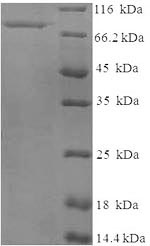The production of this recombinant Human PLAT protein is just like all recombinant proteins. The process involved transfecting E.coli cells with DNA vector containing the template of recombinant DNA. The E.coli cells containing the template were then cultured so that they could transcribe and translate the PLAT protein. N-terminal 6xHis-SUMO tag was used in the process. The purity is 90% determined by SDS-PAGE.
PLAT is a gene providing instructions for making a protein named tissue-type plasminogen activator (also known as a t-plasminogen activator, tPA). This protein is a serine protease that converts a zymogen plasminogen into an active serine protease, namely, plasmin (the primary enzyme involved in dissolving blood clots). tPA is involved in blood coagulation, cellular protein modification process, fibrinolysis, response to hypoxia, smooth muscle cell migration and trans-synaptic signaling by BDNF, modulating synaptic transmission.






